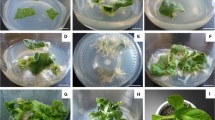Summary
When a local slow bolting variety ‘Osaka Shirona Bansei’ (Brassica rapa L. ssp. pekinensis, syn. B. campestris L. ssp. pekinensis) was grown in a phytotron (25°C, 16 hours day length without chilling treatment), one third of the plants bolted and flowered. In order to clarify the different flowering responses in the variety, a progeny line (FNC) of the flowering plants was chilled for 4 different periods (0, 22, 36 and 53 days) in a chamber of 2 ∼ 7°C, then transplanted to three different conditions, i.e. PHY: 25–20°C day and night temperatures, 16 hours day length, GHL: 10 ∼ 25°C, 16 hours day length with supplementary light and GHN: 10 ∼ 25°C, natural day length (10 ∼ 15 hours). In PHY, FNC bolted and flowered with almost the same leaf numbers in all 4 different chilling treatments. This means that FNC has very low sensitivity and no requirement to low temperature for its reproductive growth. In GHN (short day length), FNC bolted very slowly. Then the bolting and flowering of FNC were promoted by both long day length and high temperature. The newly found bolting characteristics of ‘Osaka Shirona Bansei’ could be applied to breed unique slow bolting Chinese cabbage (B. rapa L. ssp. pekinensis) which might be non-sensitive to low temperature and its bolting and flowering would be induced with the combination of long day length and high temperature. Using the unique variety, it might be also possible to establish a new cropping type of Chinese cabbage (late autumn sowing, spring harvest).
Similar content being viewed by others
Abbreviations
- PHY:
-
Phytotron, long day and high temperature condition
- GHL:
-
Greenhouse, long day and medium temperature condition
- GHN:
-
Greenhouse, natural (short) day and medium temperature condition
- FNC:
-
A progeny line of ‘Osaka Shirona Bansei’ which flowered with no chilling treatment
- FC:
-
A progeny line of ‘Osaka Shirona Bansei’ which flowered with chilling treatment
References
Elers, B. & H.J. Wiebe, 1984. Flower formation of Chinese cabbage. I. Response to vernalization and photoperiods. Scientia Hortic. 22: 219–231.
Guttormsen, G. & R. Moe, 1985a. Effect of plant age and temperature on bolting in Chinese cabbage. Scientia Hortic. 25: 217–224.
Guttormsen, G. & R. Moe, 1985b. Effect of day and night temperature at different stages of growth on bolting in Chinese cabbage. Scientia Hortic. 25: 225–233.
Honma, S., 1981. Challenges in breeding for bolt resistance in Chinese cabbage. In: N.S.Talekar & T.D.Griggs (Eds), Chinese cabbage, Proceeding of the first international symposium, pp. 451–453. Asian Vegetable Research and Development Center, Shanhua, Taiwan.
Kagawa, A., 1966. Studies on the effect of thermo-induction in floral initiation of Chinese cabbage. Bull. Fac. Agric. Gifu Univ., Japan, 22: 29–39. (in Japanese with English summary)
Mero, C.E. & S. Honma, 1984a. Inheritance of bolt resistance in an interspecific cross of Brassica species. I. Brassica napus L. × B. campestris L. ssp. pekinensis. J. Heredity 75: 407–410.
Mero, C.E. & S. Honma, 1984b. Inheritance of bolt resistance in an interspecific cross of Brassica species. II. Chikale (B. campestris L. ssp. pekinensis × B. napus L.) × Chinese cabbage. J. Heredity 75: 485–487.
Mero, C.E. & S. Honma, 1985. Inheritance of bolting resistance in an intraspecific Chinese cabbage × turnip cross. Hort. Science 20(5): 881–882.
Moe, R. & G. Guttormsen, 1985. Effect of photoperiod and temperature on bolting in Chinese cabbage. Scientia Hortic. 27: 49–54.
Shinohara, S., 1959. Genecological studies on the phasic development of flowering centering on the cruciferous crops, especially on the role of vernalization on ripening seeds. Technical Bull. Shizuoka Prefectural Agric. Exp. Sta. (in Japanese with English summary)
Suge, H., 1984. Re-examination on the role of vernalization and photoperiod in the flowering of Brassica crops under controlled environment. Japan Jour. Breed. 34: 171–180.
Suge, H. & H. Takahashi, 1982. The role of gibberellins in the stem elongation and flowering of Chinese cabbage, Brassica campestris var. pekinensis in their relation to vernalization and photoperiod. Rep. Inst. Agric. Res. Tohoku Univ. 33: 15–34.
Author information
Authors and Affiliations
Rights and permissions
About this article
Cite this article
Yui, S., Yoshikawa, H. Bolting resistant breeding of Chinese cabbage. 1. Flower induction of late bolting variety without chilling treatment. Euphytica 52, 171–176 (1991). https://doi.org/10.1007/BF00029393
Received:
Accepted:
Issue Date:
DOI: https://doi.org/10.1007/BF00029393




